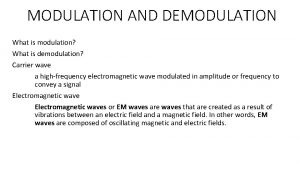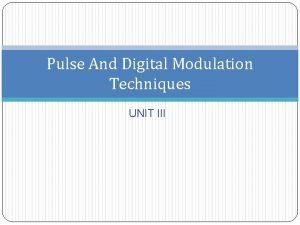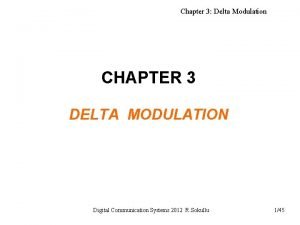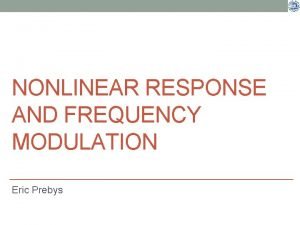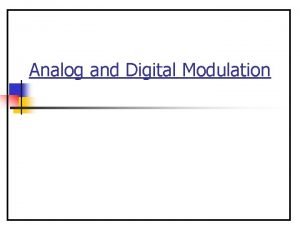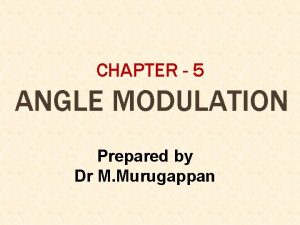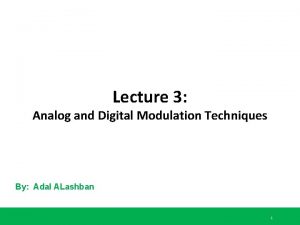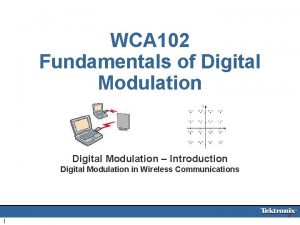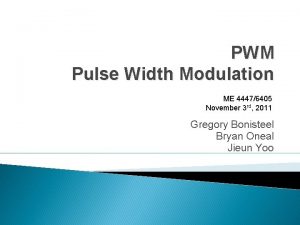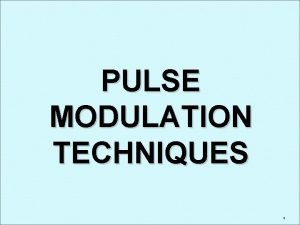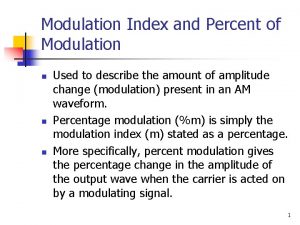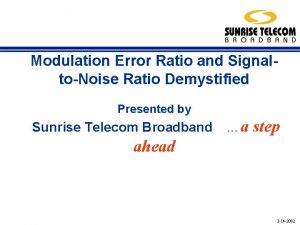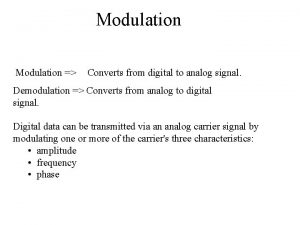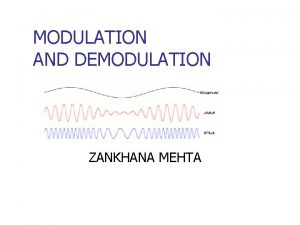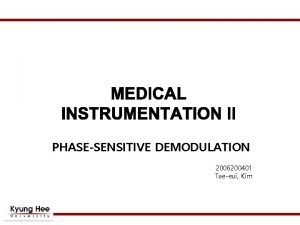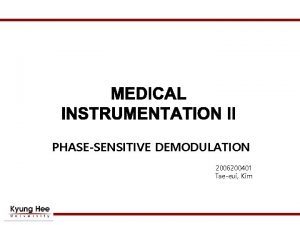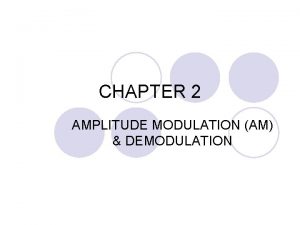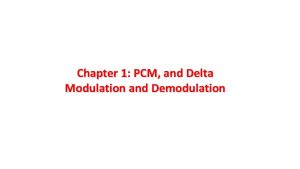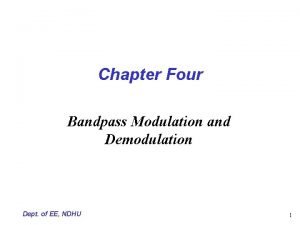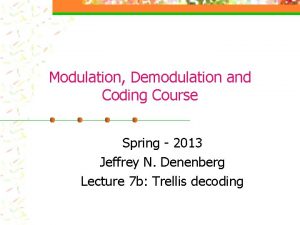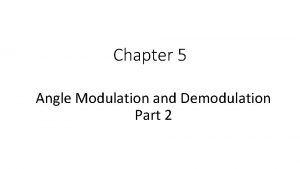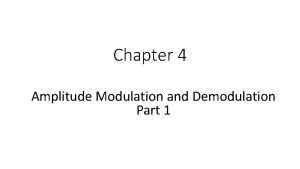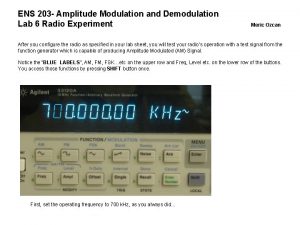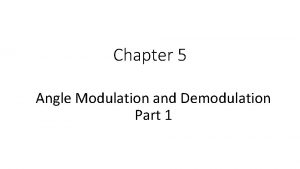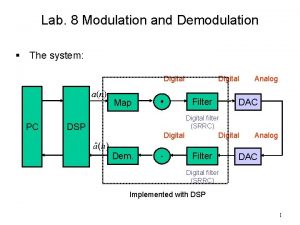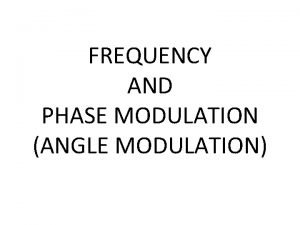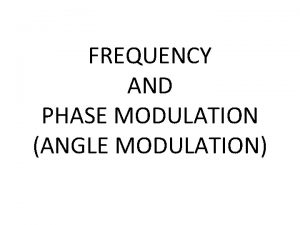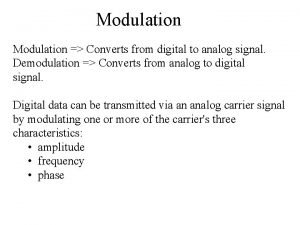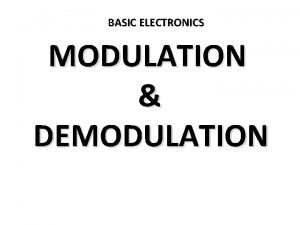MODULATION AND DEMODULATION What is modulation What is




















- Slides: 20

MODULATION AND DEMODULATION What is modulation? What is demodulation? Carrier wave a high-frequency electromagnetic wave modulated in amplitude or frequency to convey a signal Electromagnetic waves or EM waves are waves that are created as a result of vibrations between an electric field and a magnetic field. In other words, EM waves are composed of oscillating magnetic and electric fields.

Modulation • converting data into radio waves • by adding information to an electronic signal. • A carrier signal • is one with a steady waveform • constant height, or amplitude, and frequency.

Need for modualation • 1: Transmission of signal to longer distance : • To have maximum amplitude and frequency which is impossible to acquire from original signal.

Encoding and modulation • Encoding: Converting digital or analog data to digital signal • Modulation: Converting digital or analog data to an analog signal. • Encoding : Used to ensure efficient transmission and storage • Modulation : Used to send the signals to a long way

Modulation and Demodulation • Modulation Encoding information in a transmitted signal • Demodulation Extracting information from the transmitted signal.

Types of Modulation • Amplitude Modulation • Frequency Modulation • Phase Modulation

Amplitude Modulation

Frequency Modulation

Phase Modulation

Amplitude Modulation • Applications: • Used to carry message signals in early telephone lines. • Used to transmit Morse code using radio and other communication systems. • Used in Navy and Aviation for communications as AM signals can travel longer distances.

Amplitude Modulation வசச • the amplitude of the carrier wave varies with proportion to the base waveform that is being transmitted. • Types • • • Double Sideband Suppressed Carrier(DSB SC) Double side-band full carrier (Traditional Amplitude Modulation) Quadrature Amplitude Modulation (QAM) Single sideband (SSB) Vestigial sideband (VSB)

Frequency Modulation அத ரவ ண • Frequency modulation (FM) Is a technique used to encode data on an alternating digital or analog signal. The method includes varying the frequency of the carrier wave on which useful information is imposed or impressed upon.

Phase modulation கடடம • Phase modulation Used for transmitting radio waves and is an integral part of many digital transmission coding schemes that underlie a wide range of technologies like Wi-Fi, GSM and satellite television.

Superheterodyne receiver • The superheterodyne receiver • operates by taking the signal on the incoming frequency, mixing it with a variable frequency locally generated signal to convert it down to a frequency where it can pass through a high performance fixed frequency filter before being demodulated to extract the required modulation or signal.

• Superheterodyne • is basically a process of designing and constructing wireless communications such as radio receivers by mixing two frequencies together in order to produce a difference frequency component called as intermediate frequency (IF), so as to reduce signal frequency prior to processing.


AM Transmitter • Amplitude modulation (AM) is a modulation technique used in electronic communication • used transmitting information via a radio carrier wave. .

Frequency Modulation transmitter: The transmitters are those devices which is used to send frequency modulated wave through a band receivers are the devices which received modulated signal then after demodulation it gives us the original signal. Jul 8, 2015

Receiver: §The heart of a typical home theater system. The receiver • sends the video on to your television sends the audio to the decoder. • The decoder sorts out the different sound channels from the video signal • Then sends the information to amplifiers for each sound-channel output.

 Frequency modulation and demodulation theory
Frequency modulation and demodulation theory Pulse code modulation and demodulation
Pulse code modulation and demodulation Pulse code modulation and demodulation
Pulse code modulation and demodulation Demodulation of delta modulation
Demodulation of delta modulation Amplitude modulation vs frequency modulation
Amplitude modulation vs frequency modulation Amplitude modulation vs frequency modulation
Amplitude modulation vs frequency modulation Advantages of angle modulation over amplitude modulation
Advantages of angle modulation over amplitude modulation Synchronous demodulation
Synchronous demodulation Analog and digital modulation techniques
Analog and digital modulation techniques Advantage and disadvantage of dpcm
Advantage and disadvantage of dpcm Digital data digital signals
Digital data digital signals Tina champagne trauma informed care
Tina champagne trauma informed care Advantages of digital modulation
Advantages of digital modulation Modulation in translation
Modulation in translation Trail edge modulation
Trail edge modulation Granular noise occurs when
Granular noise occurs when Percent modulation formula
Percent modulation formula Meruuu
Meruuu Modulation digital to analog
Modulation digital to analog Biomechanische prinzipien schwimmen
Biomechanische prinzipien schwimmen Cross phase modulation
Cross phase modulation
